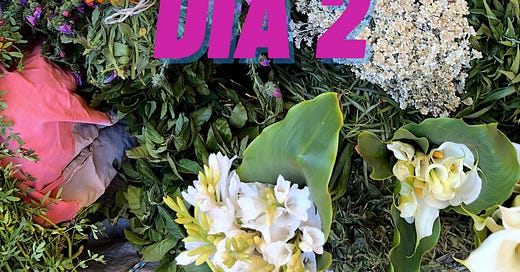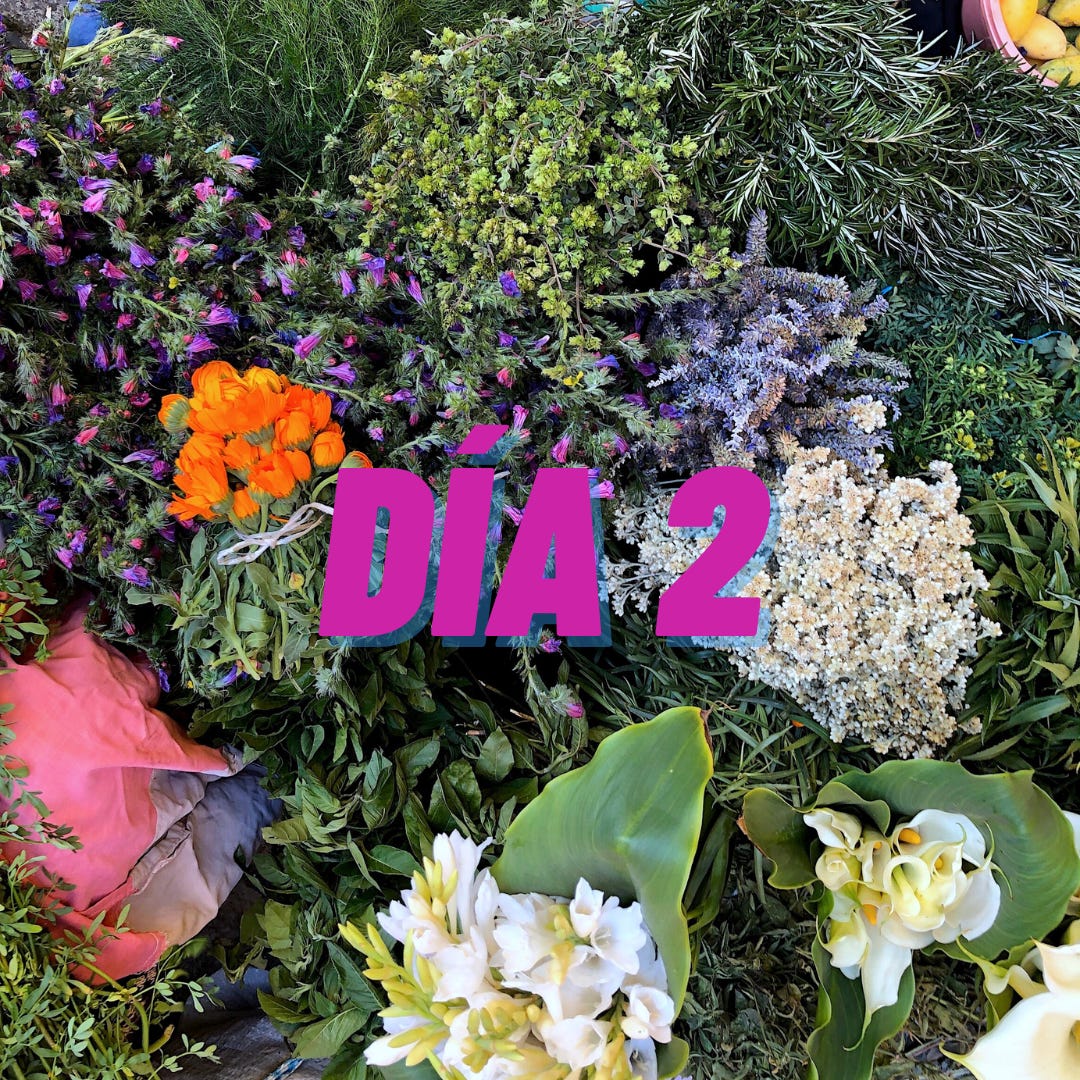This is a continuation of yesterday’s post.
*Ahora puedes escuchar este texto en español, leído por mí aquí, o al seleccionar el ícono de los audífonos arriba. Esta es una continuación del post de ayer.
But, writing is only half of the story that brings me here, the other half is, of course, food…
Cooking is a common happy place for many people. For me, it was like that from a very young age, not only as a hobby, a refuge, and self-indulging activity, but also as a way to understand the world, to connect with my abuelas and my own maternal nature, and to express what cannot always be said with words (about this topic, and goodbyes, cakes and cookbooks, I wrote this text some years ago). However, unlike communication, which, from the age of 10 or 12, I was clear that was what I wanted to major in, I never considered cooking as a profitable activity, but until much later. In that sense, the San Francisco Bay area —where I lived in the early 1990s— and Alice Waters' cooking were decisive (as I have already discussed in this newsletter); the city of San Francisco and its surroundings, for its restaurant activity during the boom of the new Californian cuisine, and Alice Waters, for her philosophy around food.
It wasn't easy escaping the lure of being a part of that world, and, while working as an office manager at a classic San Francisco restaurant called John's Grill (where Dashiel Hammet wrote The Maltese Falcon), I applied for the then, California Culinary Academy (where I later took individual workshops, as well as at the San Francisco Baking Institute and the now defunct Tante Marie Cooking Academy, among other local schools) and the CIA in New York. In the end, though, I chose to follow my initial instinct and prioritize getting a college degree. I never doubted that decision, but now that I see it in retrospect, I feel even more satisfied about having made it, because my way of understanding cooking, relating to it, and practicing it, differs a lot from the values and teachings which are mostly transmitted in culinary institutes, where the Escoffier model and the figure of the patriarchal chef still predominate.
I do believe in the professionalization of cooking, but I am convinced that there are other equally valid ways to approach it, and, in the end, the only really effective one is to be persistent, and develop discipline and intuition —with or without school. I appreciate when people refer to me as a chef, especially among colleagues in a kitchen, because it is a nice symbol of respect and camaraderie; but the title that best defines who I am is a cocinera or, in any case, a professional home cook, not because I consider one title more important or better than the other, but because they involve two different approaches to cooking, each one with its own characteristics and philosophies.
So, communication led me to magazines, and magazines led me to writing, but the fact that both activities ended up weaving one another until they became inseparable in my professional and personal life, was a fortuitous event —and, at the same time— an inevitable progression. First, because both activities were always linked in my subconscious, and also in reality, because —whether for pleasure or as a means of subsistence— I never stopped practicing them in parallel; and, in second place, because the same technological advances of the last twenty years made the combination of these two disciplines not only possible but convenient and desirable.

Today, I can create the food magazine that I want, without advertising or commercial commitments that can shape its content. Well, beyond a magazine, I can create a multi-medium, because among the new functionalities that Substack offers (which I will be telling you about in the next few days) there is the possibility of producing and integrating audio and video into the same space —two other facets of my professional training, which conveniently converge here. When I started this newsletter, I didn't realize to what extent this could be possible, not only because of my novelty in the medium but also because of the speed with which Substack flourished and became a true alternative for the sustenance of independent writing and creation. So, for this and other reasons —which I will list below— I had to pause and rethink the future of this newsletter…
The first, was the fact that, due to issues of royalties and taxes between countries, my geographical location did not allow me to access the benefits of paid subscriptions, and trying to do it through an alternate platform turned out to be more confusing and complex than I thought (still, there were people who remained as paid subscribers for all these months and who, obviously, will be rewarded accordingly). But thanks to the support of the Substack team—my new favorite community of writers in the world— and my insistence, today it is possible to do so.
On the other hand, once the above was available, and I became aware of the commitment and responsibility that this would imply, I decided to take advantage of this break as well, both to order important personal matters that I had to interrupt during the pandemic and to resume freelance work to overcome the ravages of the latter, and also, to design a new strategy and produce enough material, so that, once ATOLE NEWSLETTER was relaunched, it could be up to its greatest challenge: maintain the regularity of its publication without diminishing the quality of its content.
It is important to emphasize that, behind a large number of these newsletters, there is no production team, but a single person doing the entire job —like in my case (research, photography, texts, audio, video, cooking, testing, financing, etc.). Although this characteristic brings other advantages with it, such as the fact that ATOLE can be a free and autonomous medium that can travel with me wherever I go, and mutate along with my passions and interests, it also means that if something happens to me, the publication of this newsletter will inevitably be affected.
Aware of this situation —in the middle of my period of pause and rethinking— Substack dedicated itself to designing tools to address precisely this problem. Tools that not only facilitate the flow of content, making it more dynamic and attractive, but also allow better monetization options, foster greater interaction and collaboration amongst writers within the community, allowing a kind of organic solidarity. And, in the event that for some reason we find ourselves in the need to take a break, then have the alternative of temporarily pausing paid subscriptions —among many other perks.
In addition to allowing me to catch up with all these changes and figure out the best way to implement them in my newsletter, taking this break also gave me time to explore other newsletters, and I was amazed by the wonders I found and I keep finding every day —including authors, artists, musicians, and cooks, which I have been following for many years— and, about which, I will also be commenting on, recommending, and hopefully collaborating with, along the way. For now, you can already find some recommendations on my profile (I suggest you download the Substack app, which is like some sort of a virtual newspaper, but with only the media and people who are really interested in reading from and about).
If you are passionate about food like me, you are going to love this new version of ATOLE NEWSLETTER, a publication that —as I say in the about section— is created for people who love food, in general, cooks and just eaters, but perhaps especially for those who have an interest in learning about the food of México (not exclusively about Mexican cuisine, though its presence will inevitably predominate) in depth —street by street and road by road— beyond the usual places and characters that tend to be recurrently hyped and favored by the media.
In the next five days, prior to the official relaunch, I will introduce you, one by one, to the new sections of ATOLE NEWSLETTER, along with a small preview of what you can expect for the next month.
For now, I send you a big hug, and thank you for reading me ;)





